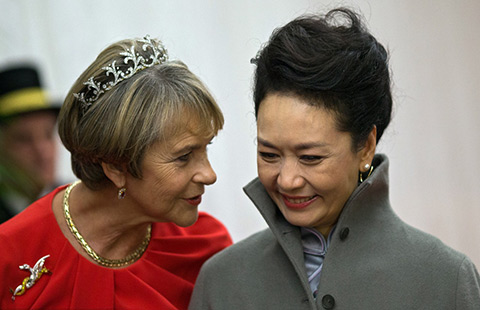

Domestic consumption and industrial restructuring can sustain country's future economic development
This year is destined to be of vital significance to China, because its traditional growth model has reached a turning point. It is now entering a period in which much can be achieved if it successfully upgrades its industrial structure, improves the quality of its labor force, promotes technological innovation and pushes ahead with system reform.
To do this requires a correct understanding of the changing international and domestic environments, so the country can respond effectively to the current challenges and gain new advantages to replace the dwindling dividends of its export-driven growth model.
China's gross domestic product last year was about 2.5 times that of 2002, while the average GDP per capita had increased 2.4 times. General Secretary of the Communist Party of China's Central Committee Hu Jintao stated in his report to the 18th National Congress, that by 2020, on the basis of making China's development more balanced, coordinated and sustainable, the GDP and per capita income for both urban and rural residents should be double that of 2010.
To realize this goal, China will have to maintain an annual growth of 7.2 percent. But there are some big challenges to overcome if it is to maintain such high-speed growth.
China's fast development over the past 30 years has been propelled by cheap labor, huge savings and large scale investments, which has resulted in a widening income gap and low consumption level. Gross national savings accounted for 38 percent of China's GDP in 1978, but they are now around 45 percent, the largest in the world.
China's reform and opening-up since the early 1980s has released some of the country's huge potential for economic growth and successfully transformed a highly concentrated planned economy into a socialist market economy with great vitality; the government's macro-control playing an important role in optimizing the use of various resources.
Reform and opening-up coincided with changes in the global industrial and labor distribution systems, as manufacturing industries, the production chains of some high-tech and new industries, and some lower-end service sectors of the developed countries moved to developing countries during this period. China became the main destination for this global industrial relocation.
China's export-oriented development strategies also increased the efficiency of its development based on foreign investment and promoted its integration into the global market.
However, the growth model driven by the dividends from huge inputs and low labor costs is now coming to an end, and the impact of the global financial crisis and the ongoing debt crisis in the eurozone have forced China to accelerate the transformation of a growth model driven by exports and investment to one that is driven by consumption.
If China can double its average personal income by 2020, about 64 trillion yuan ($10.2 trillion) will be released and China will become a large consumer market with the potential to be a new driver for global economic growth. This would also enable a rebalancing of the global economy, as China would be consuming more, while developed countries would be saving more.
China also needs to rely on domestic capital, instead of foreign capital. China's low-end advantages have attracted huge amounts of foreign capital, which have made great contributions to China's industrialization, marketization and integration into the world economy. But China now needs to translate its own capital into international competitiveness.
Courage and vision are necessary to overcome any obstacles that might hinder the fundamental structural reform that allows the market and consumption to play a greater role in future growth. For more than 60 years, the world has witnessed China's rise from an underdeveloped country to a regional power. If China can succeed in transforming its growth model, it will enter a new stage of development and become a strong global power.
The author is a researcher in economics at the State Information Center.
(China Daily 11/14/2012 page9)
 2nd China-CEEC Investment and Trade Expo held in Ningbo
2nd China-CEEC Investment and Trade Expo held in Ningbo
 Shanghai Disneyland all set for official opening on Thursday
Shanghai Disneyland all set for official opening on Thursday
 Tea sector, economic pillar of SW China's Fenggan
Tea sector, economic pillar of SW China's Fenggan
 High-end lifestyle goes mobile
High-end lifestyle goes mobile
 Nine Chinese on world's most powerful women list
Nine Chinese on world's most powerful women list
 Elderly man carries on 1,000-year old dragon boat craft
Elderly man carries on 1,000-year old dragon boat craft
 Top 10 destinations for luxury retailers in the world
Top 10 destinations for luxury retailers in the world
 Nutritious meals grow in popularity in Chinese cities
Nutritious meals grow in popularity in Chinese cities